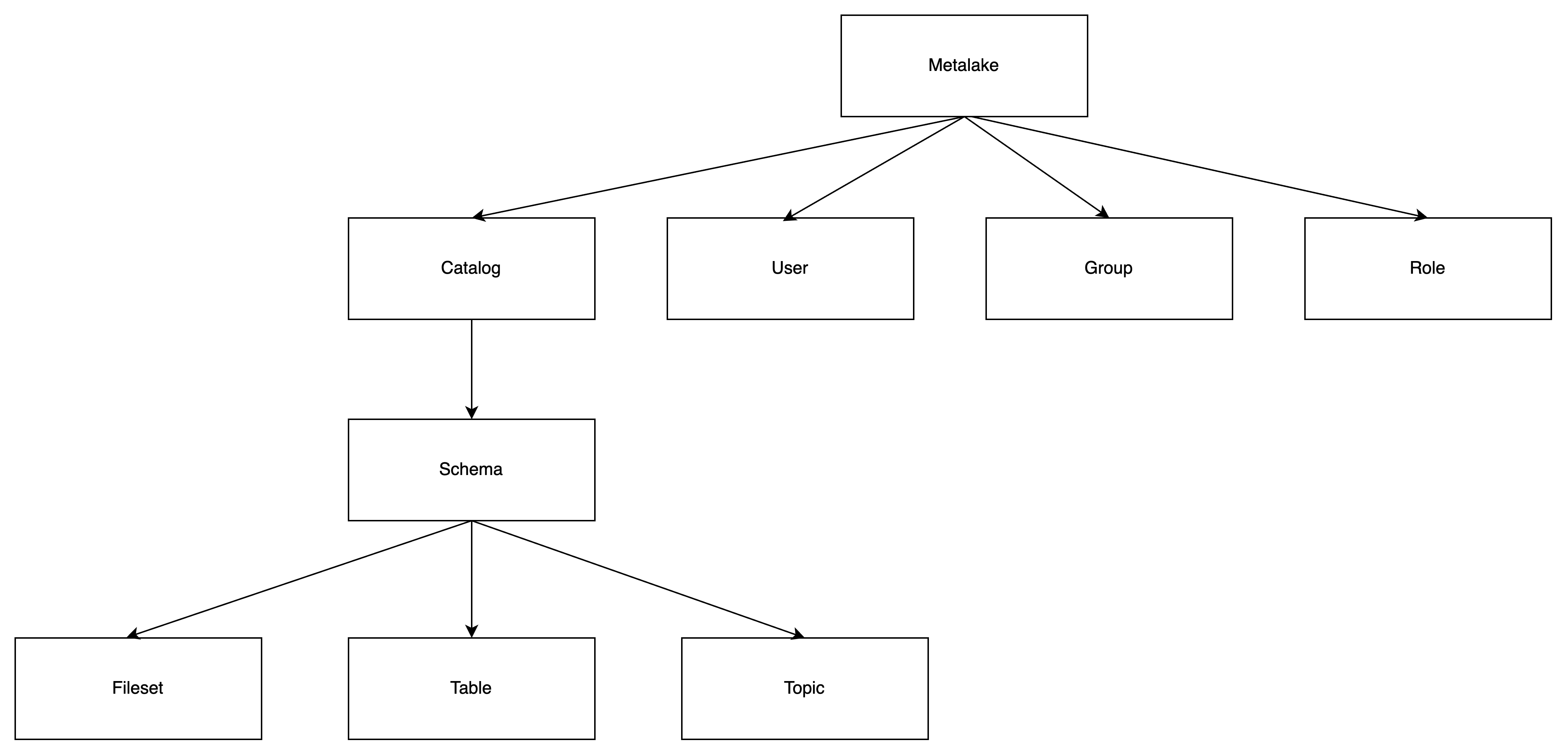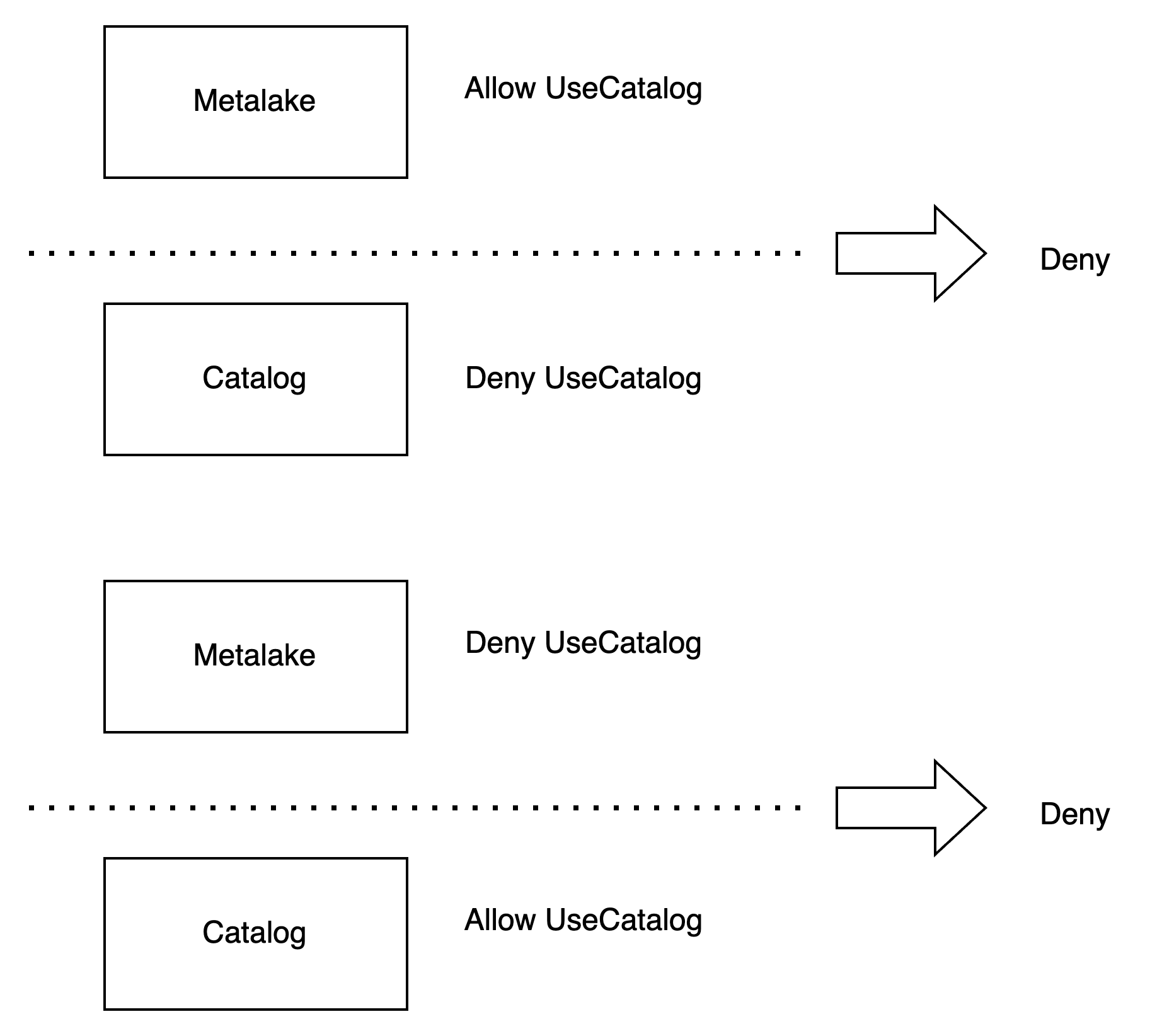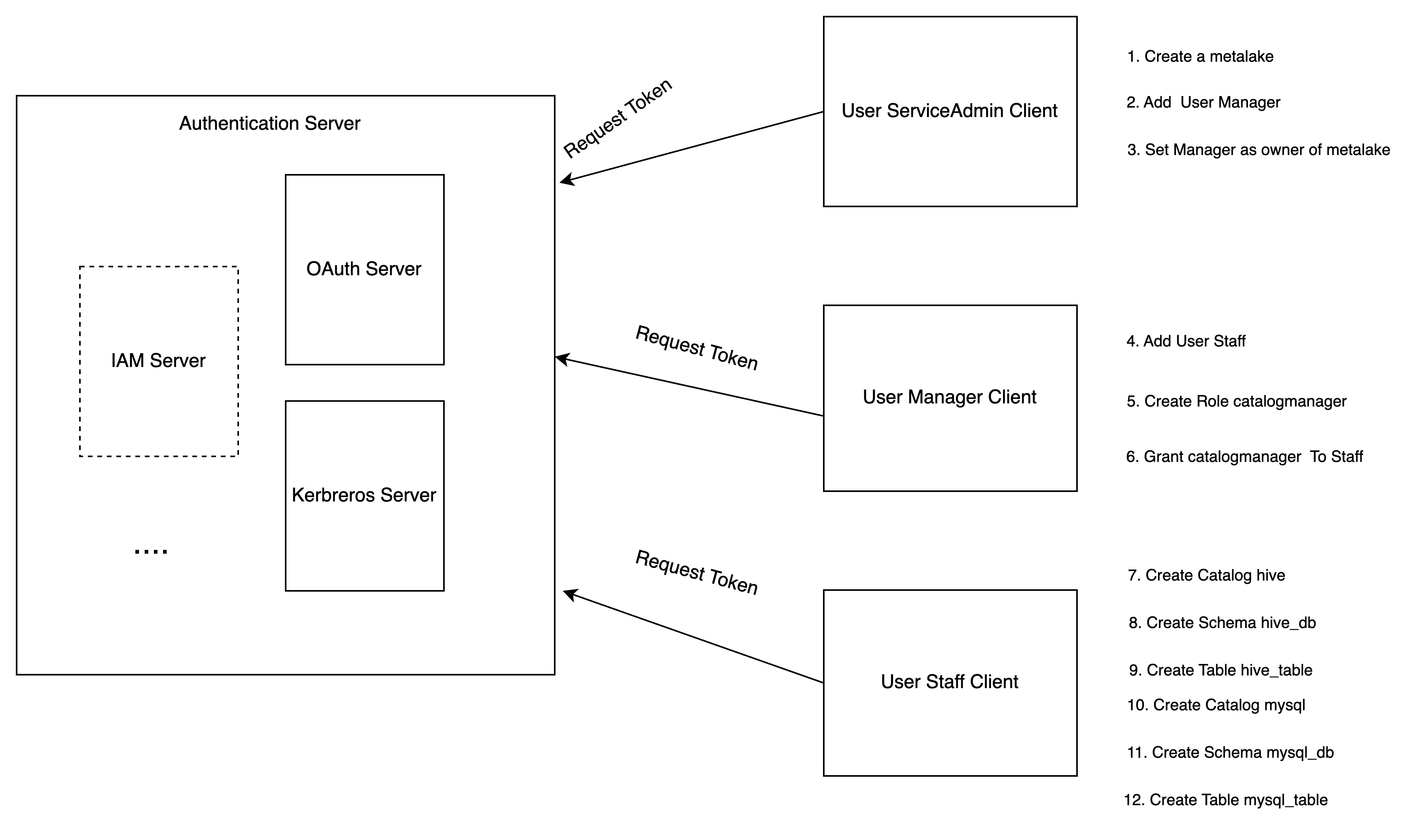Access Control
Overview
Apache Gravitino(incubating) is a technical data catalog that uses a unified metadata paradigm to manage multiple data sources while still allowing multiple engines like Spark, Trino, and Flink, or Python to connect to these data sources for data processing through Gravitino.
Because each underlying data source will have its own access control system, it can be difficult to plug in data engines with the intent of querying multiple of these data at once. This is especially important for data governance practitioners who have to worry about data access restrictions and data compliance issues, but this is streamlined through Gravitino. Therefore, in the hopes of solving this big data issue, Gravitino plans to implement a universal set of privilege models and paradigms. With this, users will be able to manage all of their data sources on a single access plane, regardless of whether the data source is a database, or a message queue or an object storage system.
After authorizing these data sources within Gravitino’s metadata lake, authentication can then be performed in Spark, Trino, and Flink Engines, as well as our Python client. This abstraction allows users to control access to data and make compliant use of the data without having to obstruct other teams and worrying about the tedious work of individual access control systems.
Gravitino Privilege Model
Gravitino’s unified management model allows for each data source to have its own authorization features. However, each data source may come with its own dedicated authorization model and methods. We may not be able to properly set permissions to the underlying system, so when a given user tries to access this data, the underlying authorization system may result in permission inconsistencies and cause issues for external access. To mitigate this issue, Gravitino aims to provide a unified authorization model and accompanying methods that sit on top of all the data sources instead, making it much easier to manage access privileges.
It is important to note that Gravitino’s authorization model will not merge the access control systems of the underlying data sources to form a large and unwieldy set of privileges. Instead, We will summarize the usage of the privileges currently in use within the data system, and offer a set of Gravitino-native privilege models that accurately reflect it.
This is so that when users and data engines use Gravitino for data processing, this permission model is used to address the complexity of managing access control for different data sources. This set of permission models is meant to keep everything within the Gravitino system while still managing the access control settings of different data sources separately.
Gravitino adopts RBAC and DAC.
Role-based Access Control (RBAC): Access privileges are assigned to roles, which are in turn assigned to users or groups.
Discretionary Access Control(DAC): Each metadata object has an owner, who can in turn grant access to that object.
Gravitino only supports authorization for securable objects, when Gravitino supports to pass the privileges to underlying authorization plugin. Gravitino doesn't support metadata authentication. It means that Gravitino won't check the privileges when Gravitino receives the requests.
Concept
Authorization
Gravitino also provides a set of authorization frameworks to interact with different underlying data source authorization systems (e.g., MySQL's own access control management and the Apache Ranger access control management system for big data) in accordance with its own authorization model and methodology. More information you can see the Authorization push down.
Authentication
As mentioned above, Gravitino uses Ownership to control the privileges of securable object in the management category and uses Role to control access securable objects, so when a user performs a specific operation on a specified resource, Gravitino will perform a composite authentication on the Ownership and Role to which the securable object belongs. When a user has more than one Role, Gravitino will use the user's current Role for authentication, and the user can switch the current Role to access a different securable object.
Role
The traditional access control system generally uses RBAC (Role-Based Access Control) for access control management, where each Role contains a collection of different operating privileges for a different securable object. When the system adds a new user or user group, you can select the Roles which they are expected to be granted to, so that the user can quickly start using it, without waiting for the administrator to gradually set up the access privileges to securable object for him.
Roles also employ the concept of ownership – the owner of a Role is by default the creator of the Role, implying the owner has all the access control to operate the Role, including deleting the Role.
Privilege
Privilege is a specific operation method for securable object, if you need to control fine-grained privileges on a securable object in the system, then you need to design many different Privileges, however, too many Privileges will cause too complicated settings in the authorization.
If you only need to carry out coarse-grained privilege control on the securable object in the system, then you only need to design a small number of Privileges,
but it will result in too weak control ability when the authentication. Therefore, the design of Privilege is an important trade-off in the access control system.
We know that Privilege is generally divided into two types, one is the management category of Privilege, such as the CREATE, DELETE resource privilege,
and the other is the operation category of Privilege, such as the READ and WRITE resource privilege.
In most organizations, the number of data managers is much smaller than the number of data users. Because it is the data users who need fine-grained privilege control, we must provide more Privileges related to usage and more tightly gatekeeper the administrative Privileges. To enforce this, we’ll introduce the concept of Ownership as a complete replacement for the administrative category of Privilege.
Ownership
When you create a securable object (Gravitino Service, Metalake, Catalog, and any other entity) in Gravitino, each entity has an Owner field that defines the user (or group) to which the resource belongs. The owner of each entity has implicit administrative class privilege, for example, to delete that securable object. Only the Owner of a securable object can fully manage that resource. If a securable object needs to be managed by more than one person at the same time, the owner is assigned to a user group.
User
Users are generally granted one or multiple Roles, and users have different operating privileges depending on their Role.
Group
To make it easier to grant a single access control to multiple users, we can add users to a user group, and then grant one or multiple roles to that user group. This process allows all users belonging to that user group to have the access control in those roles.
Metadata objects
Metadata objects are managed in Gravitino, such as CATALOG, SCHEMA, TABLE,
COLUMN, FILESET, TOPIC, COLUMN, ROLE, METALAKE. A metadata object is combined by a type and a
comma-separated name. For example, a CATAGLOG object has a name "catalog1" with type
"CATALOG", a SCHEMA object has a name "catalog1.schema1" with type "SCHEMA", a TABLE
object has a name "catalog1.schema1.table1" with type "TABLE". A METALAKE object has a name "metalake1".
Securable objects
A metadata object to which access can be granted. Unless allowed by a grant, access is denied. Every securable object resides within a logical container in a hierarchy of containers. The top container is the metalake. Catalogs are under the metalake. Catalogs represent different kinds of data sources. Schemas are under the catalog. There are tables, topics, or filesets under the schema.

The relationship of the concepts is as below.


The types of roles
Service Admin
Service admin is only used for managing the metalakes. Usually, this role is for the maintainer of the service.
Custom Roles
You can also create a dedicated role for your business by API or the client.
The types of privileges
User privileges
| Name | Supports Securable Object | Operation |
|---|---|---|
| MANAGE_USERS | Metalake | Add or remove users |
Group privileges
| Name | Supports Securable Object | Operation |
|---|---|---|
| MANAGE_GROUPS | Metalake | Add or remove groups |
Role privileges
| Name | Supports Securable Object | Operation |
|---|---|---|
| CREATE_ROLE | Metalake | Create a role |
Permission privileges
| Name | Supports Securable Object | Operation |
|---|---|---|
| MANAGE_GRANTS | Metalake | grant or revoke a role |
Catalog privileges
| Name | Supports Securable Object | Operation |
|---|---|---|
| CREATE_CATALOG | Metalake | Create a catalog |
| USE_CATALOG | Metalake, Catalog |
USE_CATALOG is needed for a user to interact with any object within the catalog.
For example, to select data from a table, users need to have the SELECT_TABLE privilege on that table and
USE_CATALOG privileges on its parent catalog as well as USE_SCHEMA privileges on its parent schema.
Schema privileges
| Name | Supports Securable Object | Operation |
|---|---|---|
| CREATE_SCHEMA | Metalake, Catalog | Create a schema |
| USE_SCHEMA | Metalake, Catalog, Schema | Use a schema |
USE_SCHEMAis needed for a user to interact with any object within the schema.
For example, to select data from a table, users need to have the SELECT_TABLE privilege on that table
and USE_SCHEMA privileges on its parent schema.
Table privileges
| Name | Supports Securable Object | Operation |
|---|---|---|
| CREATE_TABLE | Metalake, Catalog, Schema | Create a table |
| MODIFY_TABLE | Metalake, Catalog, Schema, Table | Use the SQL UPDATE,DELETE,INSERT a table |
| SELECT_TABLE | Metalake, Catalog, Schema, Table | Use the SQL SELECT data from a table |
Topic privileges
| Name | Supports Securable Object | Operation |
|---|---|---|
| CREATE_TOPIC | Metalake, Catalog, Schema | Create a topic |
| PRODUCE_TOPIC | Metalake, Catalog, Schema, Topic | Produce a topic (including alter a topic) |
| CONSUME_TOPIC | Metalake, Catalog, Schema, Topic | Consume a topic |
Fileset privileges
| Name | Supports Securable Object | Operation |
|---|---|---|
| CREATE_FILESET | Metalake, Catalog, Schema | Create a fileset |
| WRITE_FILESET | Metalake, Catalog, Schema, Fileset | Write a fileset (including alter a fileset) |
| READ_FILESET | Metalake, Catalog, Schema, Fileset | read a fileset |
Inheritance Model
Securable objects in Gravitino are hierarchical and privileges are inherited downward.
This means that granting a privilege on a metalake, catalog or schema automatically grants the privilege to all current and future objects within the metalake, catalog or schema.
For example, if you give a use that SELECT_TABLE privilege on a catalog, then that the user
will be able to select(read) all tables in that catalog.
Privilege Condition
The privilege supports two condition: ALLOW and DENY. ALLOW means that you are able to use the privilege,
DENY means that you aren't able to use the privilege.
DENY condition is prior to ALLOW condition. If a role has the ALLOW condition and DENY condition at the same time.
The user won't be able to use the privilege.
If parent securable object has the same privilege name with different condition, the securable object won't override the parent object privilege. For example, securable metalake object allows to use the catalog, but securable catalog denies to use the catalog, the user isn't able to use the catalog. If securable metalake object denies to use the catalog, but securable catalog allows to use the catalog, the user isn't able to use the catalog, too.

Server Configuration
If you want to enable the access control, you should enable the authorization.
The related configuration is as follows.
| Configuration item | Description | Default value | Required | Since Version |
|---|---|---|---|---|
gravitino.authorization.enable | Whether Gravitino enable authorization or not. | false | No | 0.5.0 |
gravitino.authorization.serviceAdmins | The admins of Gravitino service, multiple admins are spitted by comma. | (none) | Yes if enables the authorization | 0.5.0 |
If you enable authorization, you should add users to the metalake first, otherwise you will fail to create metadata objects.
If you don't set a user explicitly, you will use anonymous as the user.
When you enable authorization and create a metalake, the service will add the creator to the metalake automatically.
User Operation
Add a user
You should add the user to your metalake before you use the authorization.
- Shell
- Java
curl -X POST -H "Accept: application/vnd.gravitino.v1+json" \
-H "Content-Type: application/json" -d '{
"name": "user1"
}' http://localhost:8090/api/metalakes/test/users
GravitinoClient client = ...
User user =
client.addUser("user1");
Get a user
You can get a user by its name.
- Shell
- Java
curl -X GET -H "Accept: application/vnd.gravitino.v1+json" \
-H "Content-Type: application/json" http://localhost:8090/api/metalakes/test/users/user1
GravitinoClient client = ...
User user =
client.getUser("user1");
Delete a user
You can delete a user by its name.
- Shell
- Java
curl -X DELETE -H "Accept: application/vnd.gravitino.v1+json" \
-H "Content-Type: application/json" http://localhost:8090/api/metalakes/test/users/user1
GravitinoClient client = ...
boolean deleted =
client.deleteUser("user1");
Group Operation
Add a Group
You should add the group to your metalake before you use the authorization.
- Shell
- Java
curl -X POST -H "Accept: application/vnd.gravitino.v1+json" \
-H "Content-Type: application/json" -d '{
"name": "group1"
}' http://localhost:8090/api/metalakes/test/groups
GravitinoClient client = ...
Group group =
client.addGroup("group1");
Get a group
You can get a group by its name.
- Shell
- Java
curl -X GET -H "Accept: application/vnd.gravitino.v1+json" \
-H "Content-Type: application/json" http://localhost:8090/api/metalakes/test/groups/group1
GravitinoClient client = ...
Group group =
client.getGroup("group1");
Delete a group
You can delete a group by its name.
- Shell
- Java
curl -X DELETE -H "Accept: application/vnd.gravitino.v1+json" \
-H "Content-Type: application/json" http://localhost:8090/api/metalakes/test/groups/group1
GravitinoClient client = ...
boolean deleted =
client.deleteGroup("group1");
Role Operation
Create a role
You can create a role by given properties.
- Shell
- Java
curl -X POST -H "Accept: application/vnd.gravitino.v1+json" \
-H "Content-Type: application/json" -d '{
"name": "role1",
"properties": {"k1": "v1"},
"securableObjects": [
{
"fullName": "catalog1.schema1.table1",
"type": "TABLE",
"privileges": [
{
"name": "SELECT_TABLE",
"condition": "ALLOW"
}
]
}
]
}' http://localhost:8090/api/metalakes/test/roles
GravitinoClient client = ...
SecurableObject securableObject =
SecurableObjects.ofTable(
SecurableObjects.ofSchema(
SecurableObjects.ofCatalog("catalog1", Collections.emptyList()),
"schema1",
Collections.emptyList()),
"table1",
Lists.newArrayList(Privileges.SelectTable.allow()));
Role role =
client.createRole("role1", ImmutableMap.of("k1", "v1"), Lists.newArrayList(securableObject));
Get a role
You can get a role by its name.
- Shell
- Java
curl -X GET -H "Accept: application/vnd.gravitino.v1+json" \
-H "Content-Type: application/json" http://localhost:8090/api/metalakes/test/roles/role1
GravitinoClient client = ...
Role role =
client.getRole("role1");
Delete a role
You can delete a role by its name.
- Shell
- Java
curl -X DELETE -H "Accept: application/vnd.gravitino.v1+json" \
-H "Content-Type: application/json" http://localhost:8090/api/metalakes/test/roles/role1
GravitinoClient client = ...
boolean deleted =
client.deleteRole("role1");
Permission Operation
Grant roles to a user
You can grant specific roles to a user.
- Shell
- Java
curl -X PUT -H "Accept: application/vnd.gravitino.v1+json" \
-H "Content-Type: application/json" -d '{
"roleNames": ["role1"]
}' http://localhost:8090/api/metalakes/test/permissions/users/user1/grant
GravitinoClient client = ...
User user = client.grantRolesToUser(Lists.newList("role1"), "user1");
Revoke roles from a user
You can revoke specific roles from a user.
- Shell
- Java
curl -X PUT -H "Accept: application/vnd.gravitino.v1+json" \
-H "Content-Type: application/json" -d '{
"roleNames": ["role1"]
}' http://localhost:8090/api/metalakes/test/permissions/users/user1/revoke
GravitinoClient client = ...
User user = client.revokeRolesFromUser(Lists.newList("role1"), "user1");
Grant roles to a group
You can grant specific roles to a group.
- Shell
- Java
curl -X PUT -H "Accept: application/vnd.gravitino.v1+json" \
-H "Content-Type: application/json" -d '{
"roleNames": ["role1"]
}' http://localhost:8090/api/metalakes/test/permissions/groups/group1/grant
GravitinoClient client = ...
Group group = client.grantRolesToGroup(Lists.newList("role1"), "group1");
Revoke roles from a group
You can revoke specific roles from a group.
- Shell
- Java
curl -X PUT -H "Accept: application/vnd.gravitino.v1+json" \
-H "Content-Type: application/json" -d '{
"roleNames": ["role1"]
}' http://localhost:8090/api/metalakes/test/permissions/groups/group1/revoke
GravitinoClient client = ...
Group group = client.grantRolesToGroup(Lists.newList("role1"), "group1");
Ownership Operation
get the owner
You can get the owner of a metadata object.
- Shell
- Java
curl -X GET -H "Accept: application/vnd.gravitino.v1+json" \
-H "Content-Type: application/json" http://localhost:8090/api/metalakes/test/owners/table/catalog1.schema1.table1
GravitinoClient client = ...
MetadataObject table =
MetadataObjects.of(Lists.newArrayList("catalog1", "schema1", "table1"), MetadataObject.Type.TABLE);
Owner owner = client.getOwner(table);
set the owner
You can set the owner of a metadata object.
- Shell
- Java
curl -X PUT -H "Accept: application/vnd.gravitino.v1+json" \
-H "Content-Type: application/json" -d '{
"name": "user1",
"type": "USER"
}' http://localhost:8090/api/metalakes/test/owners/table/catalog1.schema1.table1
GravitinoClient client = ...
MetadataObject table =
MetadataObjects.of(Lists.newArrayList("catalog1", "schema1", "table1"), MetadataObject.Type.TABLE);
client.setOwner(table, "user1", "USER");
Example
You can follow the steps to achieve the authorization of Gravitino.

-
Service admin configures the Gravitino server to enable authorization and creates a metalake.
-
Service admin adds the user
Managerto the metalake. -
Service admin sets the
Manageras the owner of the metalake. -
Manageradds the userStaff. -
Managercreates a specific rolecatalog_managerwithCREATE_CATALOGprivilege. -
Managergrants the rolecatalog_managerto the userStaff. -
Staffcreates a Hive type catalog. -
Staffcreates a schemahive_dbfor Hive catalog. -
Staffcreates a tablehive_tableunder the schemahive_db. -
Staffcreates a MySQL type catalog. -
Staffcreates a schemamysql_dbfor MySQL catalog. -
Staffcreates a tablemysql_tableunder the schemamysql_db. -
Staffcan use Gravitino connector to query the tables from different catalogs.